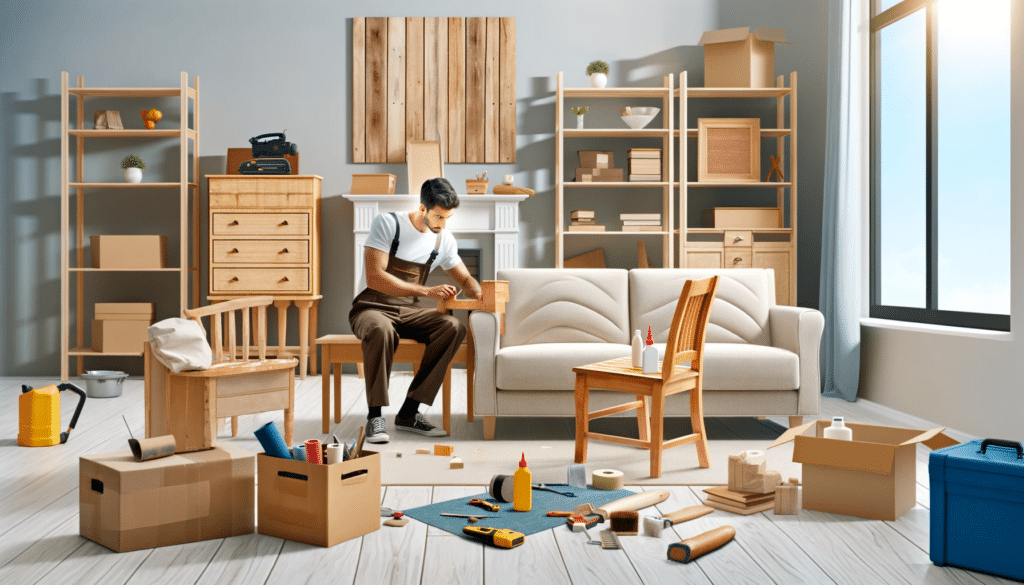
Relocating to a new home often marks a fresh start, but it can also bring unexpected challenges, particularly when it comes to your cherished furniture. The journey from one home to another, despite careful planning, can sometimes leave your furniture with unsightly scratches, dents, or even structural damage.
Understanding how to repair these damages is crucial not only for maintaining the aesthetic appeal of your furniture but also for ensuring its longevity and functionality in your new space.
For many homeowners and renters, furniture isn’t just a utility; it’s a part of their home’s personality and their own. Each piece tells a story, and damages incurred during relocation can feel like a blemish on those narratives. However, with the right approach and tools, you can restore your furniture’s beauty and integrity.
This comprehensive guide aims to empower you with practical knowledge and techniques for furniture repair post-relocation, turning what might seem like a daunting task into an achievable DIY project. Also consider reading our valuable furniture damage prevention tips for a seamless move.
Table of Contents
ToggleAssessing Furniture Damage After Relocation
Understanding the Extent of Damage
Before diving into repairs, it’s crucial to assess the extent of the damage. Start by inspecting each piece of furniture thoroughly. Look for obvious signs of wear like scratches, dents, loose parts, or fabric tears. Don’t overlook less visible areas; sometimes, the most critical damage is hidden from plain sight.
Types of Common Damages:
- Scratches and Scuffs: Often found on wooden surfaces, these can range from superficial marks to deeper grooves.
- Dents: Common in softer woods, dents can vary in depth and size.
- Structural Damage: This includes broken legs, loose screws, and misaligned parts, compromising the furniture’s stability.
- Upholstery Issues: Look for tears, rips, or stains on fabric-covered furniture.
Categorizing Damage
Once you’ve identified the damages, categorize them based on severity:
- Minor: Superficial damages that don’t affect the furniture’s functionality.
- Moderate: More noticeable damages that may require some time and specific tools to fix.
- Severe: Significant damages that might need professional intervention.
This categorization helps in prioritizing repairs and determining whether a DIY approach is feasible or if professional help is needed.
Tools and Materials Required for Furniture Repair
Repairing furniture requires not just skill but also the right set of tools and materials. Whether you’re dealing with a minor scratch or a more significant structural issue, having these essentials at hand can make the process smoother and more effective.
Basic Tool Kit for Furniture Repair
- Sandpaper and Steel Wool: Essential for smoothing out scratches and preparing surfaces for refinishing.
- Wood Filler and Putty: Handy for filling in dents and deeper scratches in wooden furniture.
- Screwdrivers and a Hammer: Crucial for tightening loose parts and minor adjustments.
- Wood Glue: For repairing loose joints or broken parts.
- Upholstery Staple Gun and Fabric Glue: For fixing tears or loose fabric.
- Paintbrushes and Stains: For touch-ups and refinishing work.
Advanced Repair Tools
For more complex repairs, you might need:
- Clamps: To hold parts together while glue dries.
- Electric Sander: For larger surfaces or extensive refinishing jobs.
- Sewing Kit: For detailed upholstery work.
- Woodworking Tools: Like chisels and saws for structural repairs.
DIY Tip: Homemade Repair Solutions
If you’re in a pinch, you can improvise with household items. For instance, minor scratches on wood can be concealed using a mixture of coffee grounds and olive oil, offering a natural, budget-friendly solution.
Basic Repair Techniques for Common Damages
Addressing common furniture damages can often be a straightforward process if you know the right techniques. This section will guide you through some basic repair methods that can effectively restore the look and functionality of your furniture.
Repairing Minor Scratches and Scuffs
- Light Scratches on Wood: Use a matching color furniture marker or crayon to fill in the scratch. Gently buff the area with a soft cloth to blend the color.
- Deeper Scratches: Apply wood filler with a putty knife, let it dry, and then sand it down smoothly. Finish by applying a matching stain or paint.
- Scuffs on Painted Surfaces: Lightly sand the scuffed area and touch up with matching paint, using a fine-bristled brush for precision.
Fixing Dents in Wood
- Steam Method: Cover the dent with a moist cloth and apply a hot iron for a few seconds. The steam can swell the wood fibers, lifting the dent.
- Filler Method: For deeper dents, fill with wood filler, let it dry, and sand it down before refinishing.
Upholstery Repairs
- Small Tears: Use fabric glue to bond the tear. For a cleaner look, hand-sew the tear using a needle and thread that matches the upholstery.
- Loose Fabric: Reattach using a staple gun or upholstery tacks, making sure the fabric is taut and even.
Safety Precautions and Best Practices
- Always work in a well-ventilated area, especially when dealing with stains, paints, or adhesives.
- Wear gloves and safety glasses to protect your hands and eyes.
- Test repair materials on an inconspicuous area first to ensure color matching and material compatibility.
Handling Complex Repairs
While many furniture damages can be addressed with DIY methods, some situations require the expertise of a professional. Knowing when to call in a specialist can save you time and ensure that your furniture is restored to its best condition.
Identifying Complex Repairs
- Structural Damages: If the integrity of the furniture is compromised, like broken frames or severely damaged joints, it’s best to consult a professional.
- Antique Furniture: Older furniture may have unique requirements and value that necessitate expert care.
- Extensive Water Damage: Extensive exposure to water can lead to mold, warping, and other issues that are challenging to fix without professional help.
Finding and Choosing Professional Repair Services
- Research: Look for reputable furniture repair services with good reviews and testimonials.
- Expertise: Ensure they have experience with your type of furniture, especially if it’s antique or unique.
- Quotes and Estimates: Get detailed quotes and understand what the repair process will involve.
Benefits of Professional Repair
- Quality Assurance: Professionals have the skills and tools to handle complex repairs.
- Durability: Expert repairs can extend the life of your furniture significantly.
- Preservation: For antiques, professional work ensures historical integrity is maintained.
Preventive Measures and Care Tips
After successfully repairing your furniture, it’s important to take steps to prevent future damages, especially during relocations. This section offers practical tips and advice to keep your furniture in top condition.
Preventive Strategies for Future Moves
- Proper Packing and Handling: Use adequate padding and protective covers, especially for delicate and wooden pieces, during moves.
- Hiring Professional Movers: Consider employing professional movers who understand how to transport furniture safely.
- Disassembling Larger Items: Take apart larger furniture items, if possible, to minimize risk during transportation.
Long-Term Furniture Care Tips
- Regular Cleaning and Dusting: This simple practice keeps furniture in good condition and allows you to spot potential issues early.
- Avoid Direct Sunlight and Moisture: Protect furniture from prolonged exposure to harsh elements that can cause fading and warping.
- Routine Maintenance: Tighten loose screws and reapply finishes as needed to maintain structural integrity and appearance.
Adapting to Lifestyle Changes
- Pet Owners: Use protective covers and regularly trim pet nails to avoid scratches and tears.
- Children’s Furniture: Choose durable materials and finishes that can withstand regular wear and tear.
When to Refinish or Replace
- Sometimes, despite best efforts, furniture may reach a point where repair is no longer viable. Assess whether refinishing or replacing is the more cost-effective and practical option.
Conclusion
In conclusion, repairing and maintaining your furniture post-relocation is a rewarding endeavor. It not only enhances the look and feel of your home but also preserves the stories and memories each piece holds. Whether through DIY methods or professional assistance, caring for your furniture is an ongoing process that reflects your commitment to creating a comfortable and inviting living space. Embrace the challenge, and take pride in keeping your furniture beautiful and functional for years to come.
Embarking on a new journey with a relocation doesn’t have to mean compromising the safety and integrity of your beloved furniture. With Atlanta Furniture Taxi, experience a seamless, stress-free move where every detail is meticulously handled by our team of professional, background-checked movers. Specializing in both residential and commercial moving services, we ensure your furniture arrives in pristine condition, ready for you to make your new house a home. Say goodbye to post-relocation furniture damages and hello to a hassle-free moving experience with the best moving company in Atlanta. Ready to make your move as smooth as possible? Contact us today and let’s get started on your journey today!





